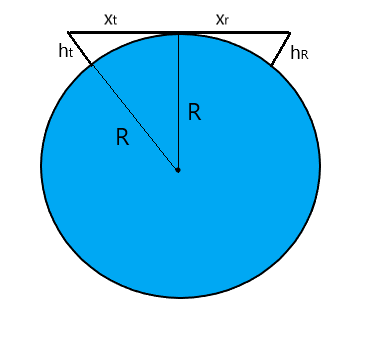Answer
64.8k+ views
Hint: The maximum line of sight is the maximum distance between the transmitting and the receiving antenna beyond which they would no longer be able to send or receive signals from one another. The curvature of the earth is what causes the distance to be finite i.e. a flat earth would have no maximum line of sight.
Formula used: In this solution we will be using the following formula;
\[hy{p^2} = op{p^2} + ad{j^2}\] where \[hyp\] is the hypotenuse of a right angled triangle, \[opp\] is the opposite side and \[adj\] is the adjacent side
Complete Step-by-Step Solution:
We shall draw two antennae on the surface of a round earth as shown in the figure

The maximum line of sight by diagram is given by
\[S = {x_t} + {x_r}\]
From Pythagoras theorem which states that
\[hy{p^2} = op{p^2} + ad{j^2}\] where \[hyp\] is the hypotenuse of a right angled triangle, \[opp\] is the opposite side and \[adj\] is the adjacent side
Hence,
\[{\left( {R + {h_t}} \right)^2} = {R^2} + x_t^2\]
\[ \Rightarrow x_t^2 = {\left( {R + {h_t}} \right)^2} - {R^2}\]
By opening the bracket and subtracting in the right hand side, we have
\[x_t^2 = {R^2} + {h_t}^2 + 2{h_t}R - {R^2}\]
\[ \Rightarrow x_t^2 = {h_t}^2 + 2{h_t}R\]
Now, if the height of the transmission antennae is taken to be small with respect to the radius of the earth, then the square of the height can be dropped as in
For \[{h_t} < < R\]. Then \[{h_t}^2 + 2{h_t}R = 2{h_t}R\].
Then the transmission antennae height can be given as
\[x_t^2 = 2{h_t}R\],
By finding the square root of both sides, we have
\[{x_t} = \sqrt {2{h_t}R} \]
Similarly, for the receiving antennae, we have that
\[{x_r} = \sqrt {2{h_R}R} \].
Then, the maximum line of sight is given by
\[S = {x_t} + {x_r} = \sqrt {2{h_t}R} + \sqrt {2{h_R}R} \]
Note: For clarity, the dropping of the square of the height can be justified through the following analysis; The equation \[{h_t}^2 + 2{h_t}R\] can be written as \[{R^2}\left( {\dfrac{{{h^2}}}{{{R^2}}} + \dfrac{{2h}}{R}} \right)\], now since, the height is small relative to the radius of the earth, then \[\dfrac{h}{R} < < 0\]. Now, from maths, we observe that when a number is less than zero, then the square of the number is even far less than zero. Hence, the first term in the bracket \[{\left( {\dfrac{h}{R}} \right)^2} \to 0\] and hence can be neglected. If we multiply \[{R^2}\], we have
\[{R^2}\left( {0 + \dfrac{{2{h_R}}}{R}} \right)\]
\[ \Rightarrow 2hR\]
Formula used: In this solution we will be using the following formula;
\[hy{p^2} = op{p^2} + ad{j^2}\] where \[hyp\] is the hypotenuse of a right angled triangle, \[opp\] is the opposite side and \[adj\] is the adjacent side
Complete Step-by-Step Solution:
We shall draw two antennae on the surface of a round earth as shown in the figure

The maximum line of sight by diagram is given by
\[S = {x_t} + {x_r}\]
From Pythagoras theorem which states that
\[hy{p^2} = op{p^2} + ad{j^2}\] where \[hyp\] is the hypotenuse of a right angled triangle, \[opp\] is the opposite side and \[adj\] is the adjacent side
Hence,
\[{\left( {R + {h_t}} \right)^2} = {R^2} + x_t^2\]
\[ \Rightarrow x_t^2 = {\left( {R + {h_t}} \right)^2} - {R^2}\]
By opening the bracket and subtracting in the right hand side, we have
\[x_t^2 = {R^2} + {h_t}^2 + 2{h_t}R - {R^2}\]
\[ \Rightarrow x_t^2 = {h_t}^2 + 2{h_t}R\]
Now, if the height of the transmission antennae is taken to be small with respect to the radius of the earth, then the square of the height can be dropped as in
For \[{h_t} < < R\]. Then \[{h_t}^2 + 2{h_t}R = 2{h_t}R\].
Then the transmission antennae height can be given as
\[x_t^2 = 2{h_t}R\],
By finding the square root of both sides, we have
\[{x_t} = \sqrt {2{h_t}R} \]
Similarly, for the receiving antennae, we have that
\[{x_r} = \sqrt {2{h_R}R} \].
Then, the maximum line of sight is given by
\[S = {x_t} + {x_r} = \sqrt {2{h_t}R} + \sqrt {2{h_R}R} \]
Note: For clarity, the dropping of the square of the height can be justified through the following analysis; The equation \[{h_t}^2 + 2{h_t}R\] can be written as \[{R^2}\left( {\dfrac{{{h^2}}}{{{R^2}}} + \dfrac{{2h}}{R}} \right)\], now since, the height is small relative to the radius of the earth, then \[\dfrac{h}{R} < < 0\]. Now, from maths, we observe that when a number is less than zero, then the square of the number is even far less than zero. Hence, the first term in the bracket \[{\left( {\dfrac{h}{R}} \right)^2} \to 0\] and hence can be neglected. If we multiply \[{R^2}\], we have
\[{R^2}\left( {0 + \dfrac{{2{h_R}}}{R}} \right)\]
\[ \Rightarrow 2hR\]
Recently Updated Pages
Write a composition in approximately 450 500 words class 10 english JEE_Main

Arrange the sentences P Q R between S1 and S5 such class 10 english JEE_Main

What is the common property of the oxides CONO and class 10 chemistry JEE_Main

What happens when dilute hydrochloric acid is added class 10 chemistry JEE_Main

If four points A63B 35C4 2 and Dx3x are given in such class 10 maths JEE_Main

The area of square inscribed in a circle of diameter class 10 maths JEE_Main

Other Pages
A boat takes 2 hours to go 8 km and come back to a class 11 physics JEE_Main

Electric field due to uniformly charged sphere class 12 physics JEE_Main

In the ground state an element has 13 electrons in class 11 chemistry JEE_Main

According to classical free electron theory A There class 11 physics JEE_Main

Differentiate between homogeneous and heterogeneous class 12 chemistry JEE_Main

Excluding stoppages the speed of a bus is 54 kmph and class 11 maths JEE_Main



